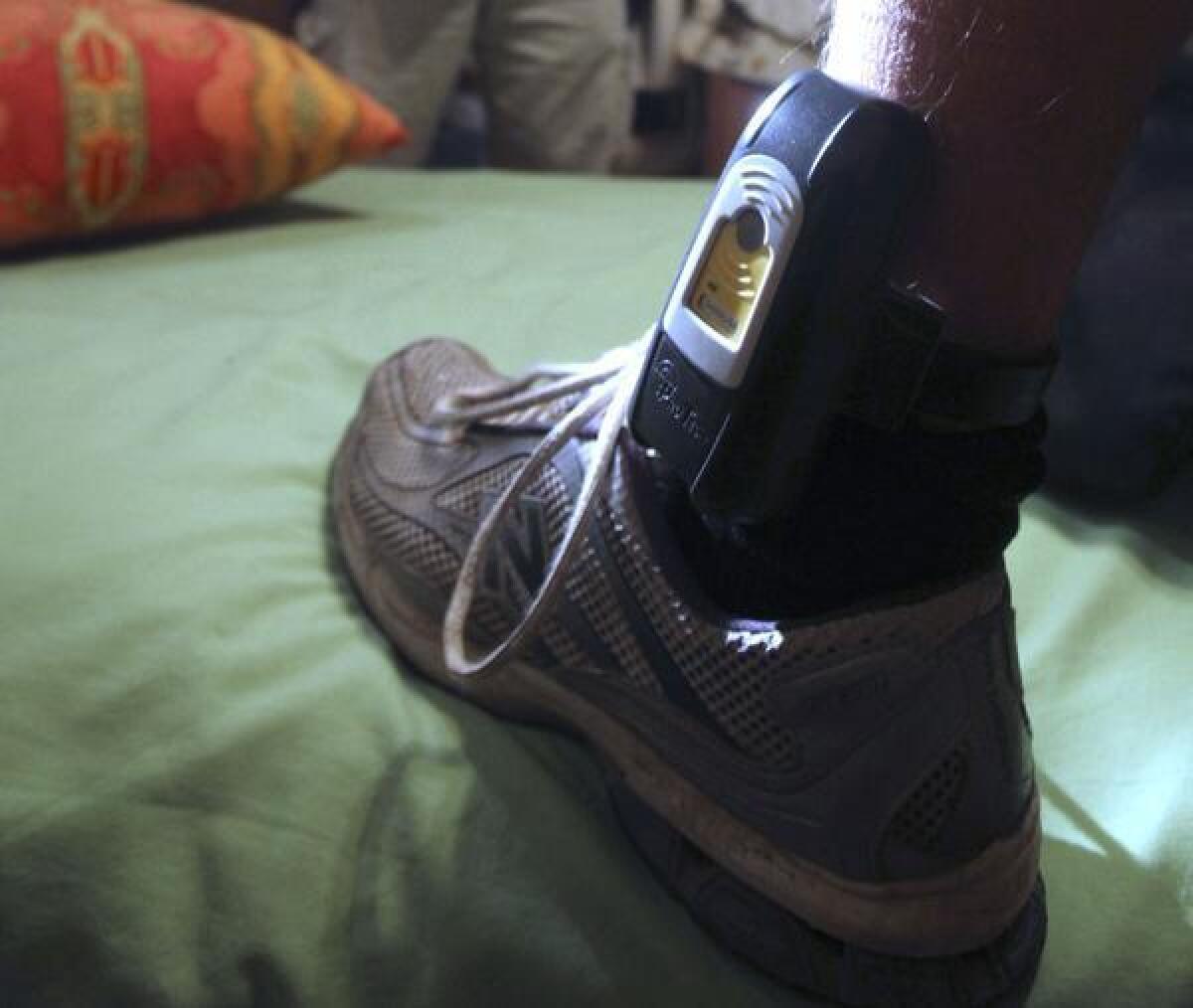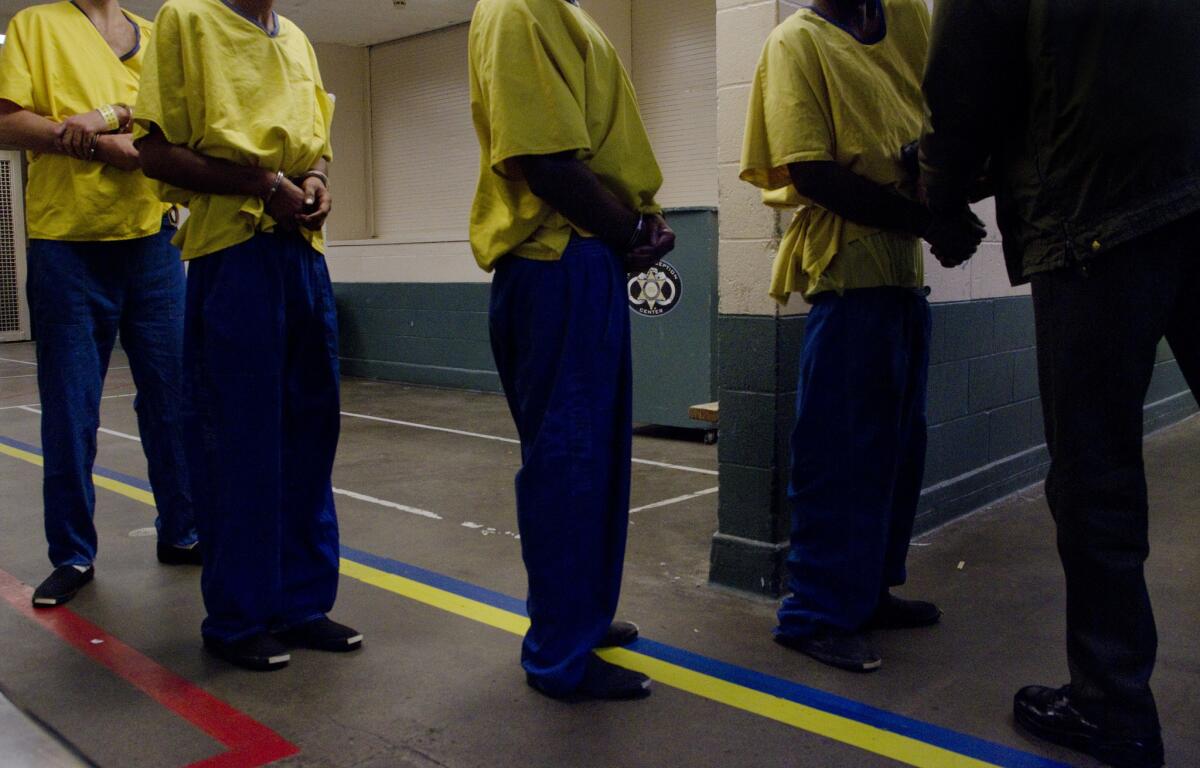Tests found major flaws in parolee GPS monitoring devices
One companyâs devices were deemed so unreliable that California ordered a complete switch to another firmâs, citing âimminent dangerâ to the public. A lawsuit ensued.
A little more than a year ago, California quietly began conducting tests on the GPS monitoring devices that track the movements of thousands of sex offenders.
The results were alarming.
Corrections officials found the devices used in half the state were so inaccurate and unreliable that the public was "in imminent danger."
Batteries died early, cases cracked, reported locations were off by as much as three miles. Officials also found that tampering alerts failed and offenders were able to disappear by covering the devices with foil, deploying illegal GPS jammers or ducking into cars or buildings.
The state abruptly ordered parole agents to remove every ankle monitor in use from north of Los Angeles to the Oregon border. In their place, they strapped on devices made by a different manufacturer â a mass migration that left California's criminal tracking system not operational for several hours.
The test results provide a glimpse of the blind spots in electronic monitoring, even as those systems are promoted to law enforcement agencies as a safe alternative to incarceration. The flaws in the equipment raise the question of whether the state can deliver what Jessica's Law promised when voters approved it in 2006: round-the-clock tracking of serious sex offenders.
In a lawsuit over the state's GPS contracting, corrections attorneys persuaded a judge to seal information about the failures, arguing that test results could show criminals how to avoid being tracked and give parole violators grounds to appeal convictions.
The information, they warned, would "erode public trust" in electronic monitoring programs. The devices, they said, deter crime only if offenders believe their locations are being tracked every minute.
The more reliable the devices are believed to be, the less likely a parolee may be to attempt to defeat the system.ââ Denise Milano
"The more reliable the devices are believed to be, the less likely a parolee may be to attempt to defeat the system," GPS program director Denise Milano wrote in a court statement.
State officials say the replacement devices have largely resolved the problems, but officials so far have refused to release test data showing what, if any, improvements were gained.
Through interviews and by comparing censored documents obtained from multiple sources, The Times was able to piece together most of what the state persuaded the courts to black out.
GPS tracking devices are designed to alert authorities if the wearer tampers with the device, tries to flee or strays too close to a school or other forbidden area. Currently, 7,900 high-risk California parolees and felons â most of them sex offenders or gang members â wear the devices strapped to their ankles.
The monitors work by picking up signals from GPS satellites and transmitting the location information by cellular networks to a central computer. Just like GPS devices used by drivers or hikers, the monitors can fail where buildings block signals or where cell reception is spotty.
But that is not the monitoring system's sole vulnerability: A Times investigation in February found that thousands of child molesters, rapists and other high-risk parolees were removing or disarming their tracking devices â often with little risk of serving time for it because California's jails are too full to hold them.
The state's testing was conducted as part of a winner-take-all contest for the nation's largest electronic monitoring contract, worth more than $51 million over six years. Industry experts said they were the most exhaustive field trials they had seen.
When statewide monitoring began in 2008, California split the work between a division of 3M Co. and Houston-based Satellite Tracking of People, or STOP. The 3M device was used to track some 4,000 parolees in all but six Southern California counties. STOP had the rest of the state, including Los Angeles.
When California later sought to switch to a single provider, 3M came in with the low bid.
For a week in late 2011, parole agents abused both companies' devices. They were dropped four feet onto concrete, wrapped in foil to block their signals and submerged as long as three hours in a swimming pool. Testers allowed batteries to run dead, cut ankle straps and traveled into areas beyond the reach of satellite and cellular phone signals.
Testers allowed batteries to run dead, cut ankle straps and traveled into areas beyond the reach of satellite and cellular phone signals.
Without revealing full details of the tests, officials declared 3M's devices so faulty that the state rejected the company's bid. When 3M protested, Milano began a second round of tests that she said showed 3M's ankle monitors posed a public safety emergency.
The state claimed that 3M's devices failed to meet 46 of 102 field-tested standards for the equipment, although the company said a fourth of the failures occurred because the state had not provided the phone numbers needed to send automated text alerts.
One agent who participated in the tests, Denise LeBard, said in a court statement that 3M's ankle monitors were "inundated with defects."
Among the problems: 3M's devices failed to collect a GPS location every minute, phone in that information every 10 minutes and forward a text message to a parole agent if a problem was detected. Without revealing how well STOP performed, the state said 3M collected only 45% of the possible GPS points.
Testers also were able to fool 3M's GPS devices by wrapping monitors in foil, something that triggers an alarm on STOP's device because it has a metal detector.
Engineers and experts within 3M's electronic monitoring division vigorously dispute the alleged faults. They accused California of rigging the tests to steer the contract to STOP.
"This is one agency's testing," said Steve Chapin, vice president of government relations for 3M's electronic monitoring division. "We have the most widely used system in the world. It's been proven time and time and time again to be very safe and reliable."
Neither 3M nor STOP can produce a device that will read the offender's mind to determine his or her intent, so the devices can only 'assume' that a tamper is intentional.ââ 3M statement
In a heavily censored declaration, Milano also disclosed a test in which the 3M ankle monitor failed to "wake" from a battery-saving sleep mode, creating uncertainty about an offender's location. She cited the rest mode issue, along with what she described as a four-year history of other problems, as grounds to order parole agents in April 2012 to immediately replace every state-issued 3M monitor in California with one from STOP.
3M argued in court that GPS signals are blocked so frequently that no ankle monitor can really distinguish between accidental and deliberate interference. Its device triggers tamper alerts only when both GPS and cell signals are lost for more than two minutes, a feature even the company said is not foolproof.
"Neither 3M nor STOP can produce a device that will read the offender's mind to determine his or her intent, so the devices can only 'assume' that a tamper is intentional," 3M said.
A Sacramento County judge in February ruled that Milano had violated state contract laws, but he upheld her decision that 3M failed state standards.
Industry experts say the issues raised with 3M are not unique to that company, and problems with the state's monitoring system probably still exist.
Peggy Conway, editor of the Journal of Offender Monitoring, said every electronic monitoring system has blind spots and weaknesses.
"There is no one perfect product," she said.
Follow Paige St. John(@paigestjohn) on Twitter
Sign up for Essential California
The most important California stories and recommendations in your inbox every morning.
You may occasionally receive promotional content from the Los Angeles Times.













